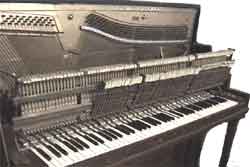



Roy E. Howard
PianoConcerto.m4a
PianoConcerto.mp3
The piano tuner holds a unique role in society: to bring harmony to discord. The tuner usually works quite alone, raising the pitch and making exquisitely fine adjustments to hundreds of tuning pins, hammers, keys, and other action parts. Imagine what the world could be like if his dedication and integrity were copied by others. In this fanciful composition, the orchestra is inspired by the tuner's efforts, and joins in the struggle to resolve conflict.
1. Setting the Temperament. 0:00 to 1:38. The piece begins with a single note played by the flute: C above middle C. The tuner uses this as a standard to bring the piano up in pitch one whole note. The temperament octave is set and checked with descending thirds, all in the first one minute and 38 seconds.
2. Raising the treble octaves. From 1:38 to 2:21 the tuner raises the pitch of the treble octaves. The orchestra glissando effect represents raising the pitch one whole step for each of the 88 notes in the scale. Since each beat is a half step from the last, the orchestra is challenged to create a unique melody and harmonic progression.
3. Raising the bass section. 2:21 to 2:53. The bass section is raised, with equivalent low notes played by the brass section.
4. Tuning the unisons. 2:53 to 3:41. Piccolo and flute represent the highest notes as the piano plays the entire chromatic scale, representing the tuning of unisons. As the tuner descends the scale, all the orchestra eventually joins in, including the lowest strings in the deep bass.
5. Checking the outcome. 3:41 to 3:54. The pitch raise is done, and the tuner and orchestra join in playing low and high notes in perfect harmony. Mission accomplished in less than 4 minutes!
May your efforts in bringing harmony to the world
become contagious and practiced in families, communities, and countries!
| go to Howard Piano Service | Go to Roy Howard, Composer |
| Order CD: $10 includes shipping (this concerto settles the question of whether piano tuning can be a musical experience) | or order DVD "A Demonstration of Vertical Piano Regulation" $15, that includes the Concerto and other Roy Howard originals as accompaniment |
| The Future of the Piano | 316 634 1148 |
|
Video: "A
Demonstration of Vertical Action Regulation" by Roy E. Howard.
Shows all the steps in this 10 hour procedure in 10 minutes. Call
to schedule action regulation for your piano.
"Piano
preparation involves lots and lots of mechanical details, all of which
come together to make that conglomeration of metal, wood and felt into
something magical, with the potential for being the conveyer of "living
music", at which point it almost takes on life itself." |
|
| Call for an evaluation of your piano's action regulation. Over time, moving parts wear, and relationships between action components change. Action regulation improves touch and tone. |